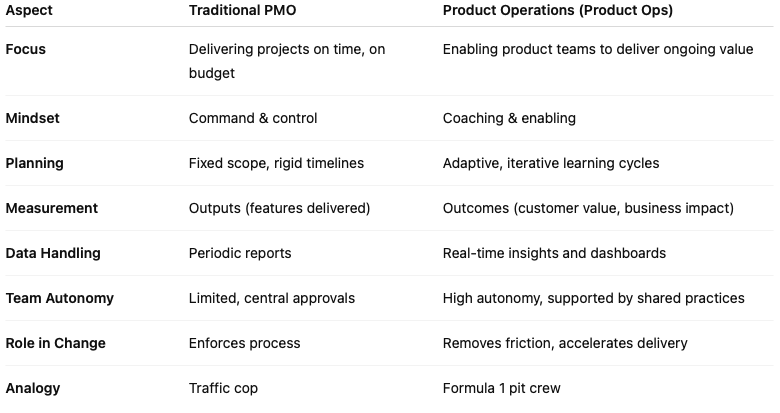When Microsoft transitioned Office to the cloud, they threw out their shopping list of features and started chasing outcomes like faster collaboration and stickier adoption. ING Bank also made a similar move - ripping up their feature factories and handing teams a compass instead of a map.
The sad truth? In many organisations, roadmaps are nothing more than wishlists with due dates. Stakeholders fight for their pet features, IT and Tech playing feature Tetris, and teams slogging toward a delivery date everyone knows is fantasy. The result: burned-out teams, wasted investment, and solutions that miss the mark.
Outcome-led roadmaps flip that script. At its core, an outcome-led roadmap is a plan that focuses on the changes and benefits you want to deliver to customers or the business, rather than on specific features. It stops asking “What can we ship?” and starts asking “What’s the impact we’re here to make?”—shifting from counting features to counting real wins.
In my experience working with organisations moving through the transformation from top-down feature factories to outcome-focused and autonomous teams, there are some distinct plays I've seen repeatedly deliver success. Here’s how to start kicking feature factories to the curb:
1. Start with the Mountain, Not the Map
Think of your roadmap as a mountain expedition. Features are like individual supplies or steps along the path. Useful, yes, but meaningless if you’re climbing the wrong peak. Outcomes define the mountain itself: reducing churn by 20%, doubling digital adoption, or increasing average revenue per customer.
In fact, according to Pendo's Feature Adoption Report, only 12% of product features generate 80% of total usage—proof that without clear outcomes, most of what gets built ends up as unused clutter.
When you start with a clear outcome, the route can change. Some gear (features) will get tossed. Others will be improvised. But everyone knows what summit they’re trying to reach.
2. Turn Outputs into Hypotheses
Teams often get stuck phrasing solutions as fixed features. Take a loyalty program as an example: rather than just saying “Build loyalty program feature”, reframe it as a hypothesis tied to an outcome:
“We believe introducing a loyalty program will increase repeat purchases by 15% in 6 months.”
This subtle shift does two powerful things:
Makes room for experimentation (maybe the solution isn’t a loyalty program at all)
Creates accountability for impact, not just delivery
Companies using hypothesis-driven planning see 33% faster validation of ideas (Lean Product Research Report, 2022).
3. Link Roadmaps to Metrics, Not Milestones
Feature-based roadmaps celebrate delivery dates. Outcome-led ones celebrate movement in metrics.
Swap milestone charts for metric dashboards. Show the trend in churn rate, activation, or NPS alongside planned initiatives. That way, every conversation is about closing the gap, not checking boxes.
4. Shorten the Horizon, Extend the Vision
Traditional roadmaps pretend we can predict 12–18 months of development. In complex systems, that’s fantasy.
Outcome-led roadmaps set a long-term vision (the mountain peak) but only detail near-term bets (the next few camps). This balances strategic clarity with agility, allowing teams to adapt as they learn.
A recent Agility Index study found that organisations using shorter planning cycles (e.g., quarterly) adapt to market changes 40% faster than those locked in annual plans.
5. Empower Teams to Choose the Path
Executives often mistake specifying features as providing direction. In reality, they’re constraining innovation. Set the outcome and the boundaries (budget, timelines, risk tolerance), then let product teams figure out the best way forward.
This shift pays dividends. Empowered teams report 50% higher engagement, and individuals who feel empowered score in the 79th engagement percentile vs 24th when disempowered.
Outcome-led planning only works when decision-making is pushed closer to those doing the work. But empowerment doesn’t mean chaos. Teams must maintain alignment with the organisation’s strategic direction.
Think of it as aligned autonomy: teams have the freedom to choose their path but must still point their compasses toward the same mountain peak defined by leadership.
But What About Infrastructure and Re-platforming Projects?
A classic argument against outcome-led planning in technology teams is: “You need to build the plane before you can fly it.”
While some platforms truly require large foundational builds, the point isn’t to avoid building the plane. It’s to design and deliver it in stages that prove value along the journey:
Challenge the either-or decision: You don’t need a finished Airbus to prove lift. Can you start with a glider? Infrastructure can show incremental outcomes like faster provisioning times, reduced downtime, or lower compute costs long before the full build is done.
Think modular planes: Just like modern aircraft use modular, tested components. For example, cockpit apparatus and flight controls can be tested in isolation long before the fuselage and wings are assembled. Similarly, platform teams can build minimum viable platforms, validate them with real workloads, then expand.
Tie to business outcomes: Even infrastructure exists to serve a business result - speed, reliability, scalability. Express platform work in these terms: “We believe that <solution> will increase CRM stability, and therefore reducing negative Customer Experience reviews by 3%”
Run flight tests: Don’t wait 12 months to prove success. Pilot workloads, release partial capabilities to a single business unit, and iterate.
Final Thought: Stop Measuring Progress in Tickets
Shifting to outcome-led roadmaps is more than a formatting change - it’s a cultural and mindset shift. You’re moving from project management to product leadership. From busy work to business impact.
In mountaineering terms: stop counting footsteps and start watching the horizon. Because no one gets remembered for building features on time - they get remembered for the value they created.






